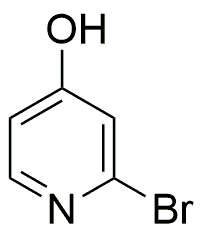2-Bromo-4-hydroxypyridine is widely utilized in research focused on:
- Pharmaceutical Development: This compound serves as an important intermediate in the synthesis of various pharmaceuticals, particularly in the development of anti-inflammatory and anti-cancer agents.
- Agricultural Chemicals: It is used in the formulation of agrochemicals, including herbicides and fungicides, enhancing crop protection and yield.
- Material Science: The compound is explored for its potential in creating novel materials, particularly in the development of polymers and coatings with improved properties.
- Analytical Chemistry: It acts as a reagent in various analytical methods, aiding in the detection and quantification of other compounds in complex mixtures.
- Biochemical Research: Researchers utilize it in studies related to enzyme inhibition and receptor binding, contributing to our understanding of biological processes.
General Information
Properties
Safety and Regulations
Applications
2-Bromo-4-hydroxypyridine is widely utilized in research focused on:
- Pharmaceutical Development: This compound serves as an important intermediate in the synthesis of various pharmaceuticals, particularly in the development of anti-inflammatory and anti-cancer agents.
- Agricultural Chemicals: It is used in the formulation of agrochemicals, including herbicides and fungicides, enhancing crop protection and yield.
- Material Science: The compound is explored for its potential in creating novel materials, particularly in the development of polymers and coatings with improved properties.
- Analytical Chemistry: It acts as a reagent in various analytical methods, aiding in the detection and quantification of other compounds in complex mixtures.
- Biochemical Research: Researchers utilize it in studies related to enzyme inhibition and receptor binding, contributing to our understanding of biological processes.
Documents
Safety Data Sheets (SDS)
The SDS provides comprehensive safety information on handling, storage, and disposal of the product.
Product Specification (PS)
The PS provides a comprehensive breakdown of the product’s properties, including chemical composition, physical state, purity, and storage requirements. It also details acceptable quality ranges and the product's intended applications.
Certificates of Analysis (COA)
Search for Certificates of Analysis (COA) by entering the products Lot Number. Lot and Batch Numbers can be found on a product’s label following the words ‘Lot’ or ‘Batch’.
Numéro de catalogue
Numéro de lot/série
Certificates Of Origin (COO)
This COO confirms the country where the product was manufactured, and also details the materials and components used in it and whether it is derived from natural, synthetic, or other specific sources. This certificate may be required for customs, trade, and regulatory compliance.
Numéro de catalogue
Numéro de lot/série
Safety Data Sheets (SDS)
The SDS provides comprehensive safety information on handling, storage, and disposal of the product.
DownloadProduct Specification (PS)
The PS provides a comprehensive breakdown of the product’s properties, including chemical composition, physical state, purity, and storage requirements. It also details acceptable quality ranges and the product's intended applications.
DownloadCertificates of Analysis (COA)
Search for Certificates of Analysis (COA) by entering the products Lot Number. Lot and Batch Numbers can be found on a product’s label following the words ‘Lot’ or ‘Batch’.
Numéro de catalogue
Numéro de lot/série
Certificates Of Origin (COO)
This COO confirms the country where the product was manufactured, and also details the materials and components used in it and whether it is derived from natural, synthetic, or other specific sources. This certificate may be required for customs, trade, and regulatory compliance.


